Sound the Ringing Cry
“Why a War Cry?” Because the war cry is victory! “Victory over sin, victory over poverty, victory over despair.”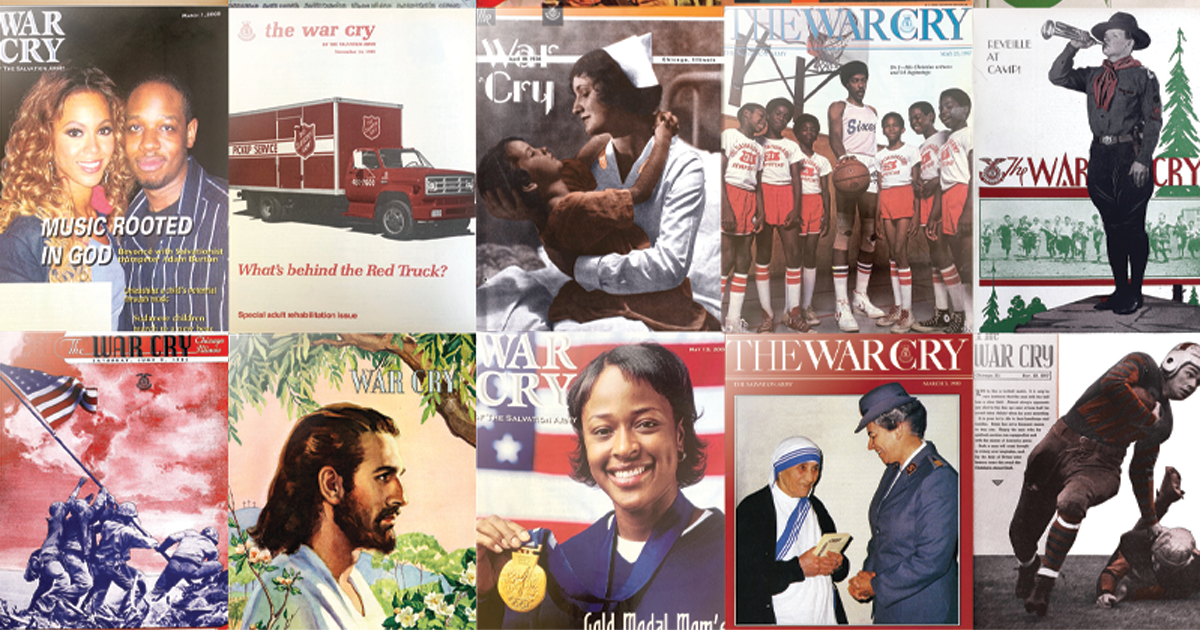
This year marks the 140th anniversary of The War Cry, one of the oldest, continuously printed magazines in the United States. The first American version of the magazine was published by Commissioner George Scott Railton in St. Louis on January 15, 1881.
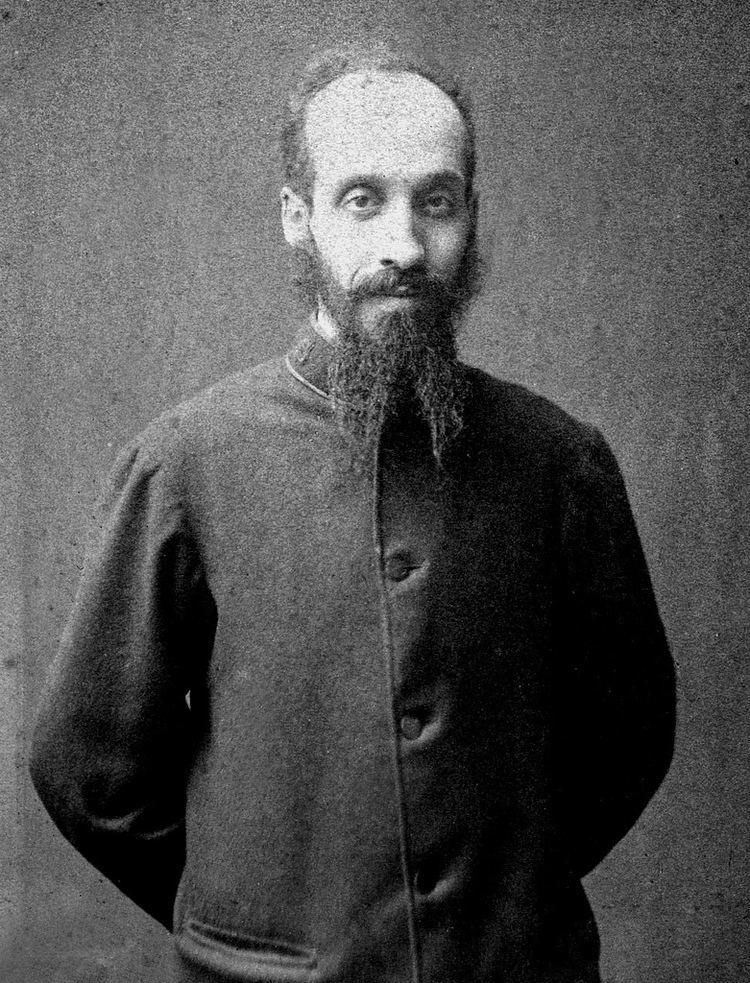
Railton, a Scottish-born Christian missioner, was the first commissioner of The Salvation Army and third in command to its Founder, General William Booth. A gifted writer, he wrote “The Fifty Articles of War” in The Christian Mission Magazine from October 1872 until June 1878. He came to the United States in 1880 as the pioneer of The Salvation Army in the United States. He published a small newsletter titled Salvation News. After moving to St. Louis, Railton published the first American issue of The War Cry, printing about 100 copies and distributing them by hand.
The early U.S. versions were more like the newspapers of the day and only contained four pages. Over the years, the page count expanded as the Army grew in scope and size. Pictures were often small and hand drawn or illustrated. In some instances, special versions were printed in color ink, such as red, blue or green.
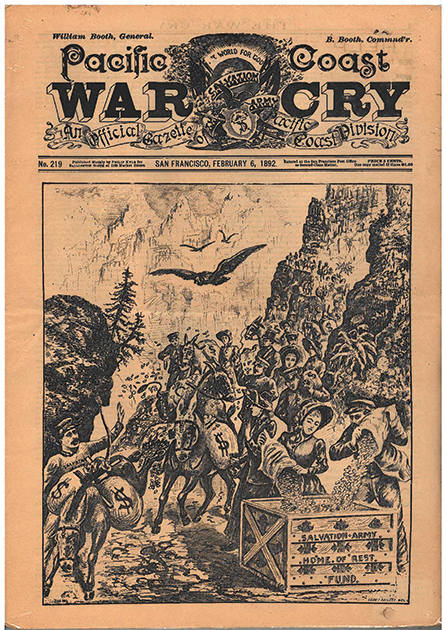
Out in the West coast, a battered copy of The War Cry from London reached the streets of San Francisco in 1882. After reading its contents, the Pacific Coast Holiness Association promptly and by unanimous decision changed their name to The Salvation Army, appointed a commander and started preaching the Gospel and helping the poor. They also printed a version of The War Cry. This paper was only published monthly, unlike the weekly War Cry back east. The Western Salvation Army was folded into the international Army in 1883, when Major Alfred Wells was sent from London to “take over” the work.
By the time of Wells arrived, the earlier successes were gone, and most of the members had moved on to other adventures. However, a few faithful soldiers remained, and reinforcements were sent from London and New York. One of those who remained was Sergeant John Milsaps. He became editor of the western War Cry in 1886 and developed it into a weekly newspaper/magazine by 1889.
Back east in New York, trouble was brewing. Major Thomas Moore took over as commander in the United States, succeeding Railton. Since corporate laws were drastically different in America, Moore became a U.S. citizen, and tried to explain the situation to William Booth back in London. The General could not (or would not) understand Moore’s pleas, and refused the request for The Salvation Army to incorporate in the United States.
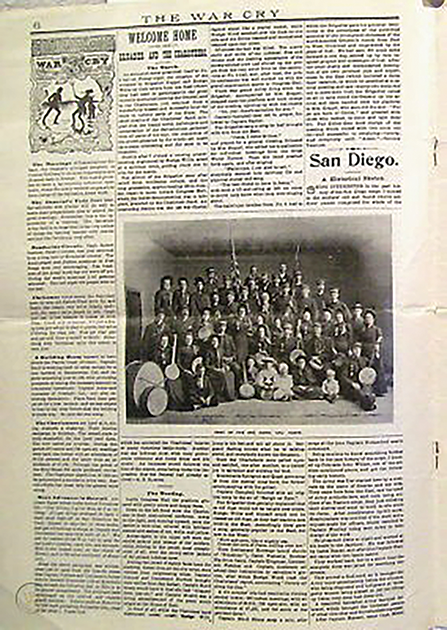
Moore decided to do it anyway, and by 1884, The Salvation Army was duly incorporated in the United States. Moore also copyrighted all Army insignia and The War Cry. For the next five years, confusion raged across the eastern U.S. London dispatched Major Frank Smith, who set up a rival headquarters, published a “loyal” War Cry, and summarily dismissed all disloyal officers. At one time in the eastern parts of the country, there were three rival Salvation Army groups. Soon, Moore’s Salvation Army withered and died. He was ousted from leadership, and the “Salvation Army of America” was quietly folded back into The Salvation Army by 1889.
The one major change that occurred at this time was the change of The Salvation Army crest. The crown was converted into an eagle, symbolizing the wings on which the redeemed shall mount up (Isaiah 40:31). American Salvationists found it patriotic. The eagle would remain The Salvation Army crest in America until 1982, when it was replaced with the crown again. Soon dubbed “the illegal eagle,” it could be seen on buildings, insignia and occasionally letterheads and forms well into the 1990s.
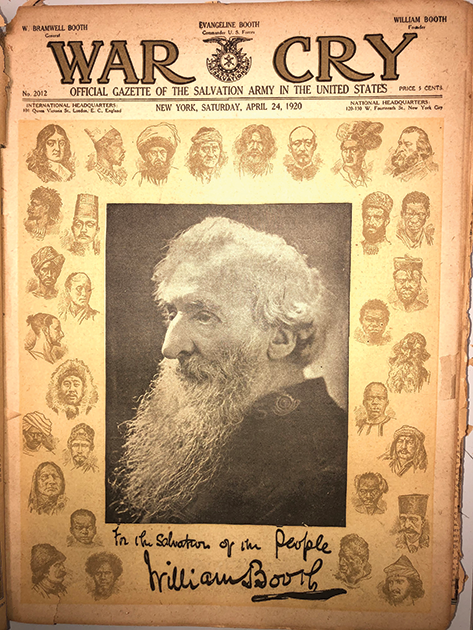
The War Cry hit its full stride after the 1890s. Full color fully illustrated covers appeared in the early 1900s, but these too were often special editions. Turning into more of a weekly magazine, The War Cry was used to spread the Army’s message, carry news about the Army’s work and help fund the local corps. In some instances, officers would take to the streets with an armload of War Crys and go door-to-door in homes and businesses. Dedicated Salvationists would go on weekly tavern runs and door to door to share the magazine and raise money in return.
The faithful efforts to share The War Cry endeared it and the Army to many, including those who at first blush would resist the “do-gooders.” In some cases, this not only funded the corps but also paid their allowances. The War Cry would carry results of War Cry proceeds to encourage distribution and note the successes.
From 1920 until 1927, each of the three U.S. territories began publishing its own version of The War Cry. After the U.S. was further divided into four territories in 1927, the four territories continued to publish these regional versions.
One amusing anecdote from the early 1960s involved a cadet who wore his “worst” uniform on the days that the cadets went into the city to sell copies of The War Cry. “The brown-black ink would rub off, and turn my sleeves brown, and after a few weeks, it would not wash out. So, on those days, I wore my ‘War Cry tunic’ and did not worry about the ink stains. After training was completed, I tossed that uniform away.” In 1970, the four U.S. territories agreed to publish one national War Cry.
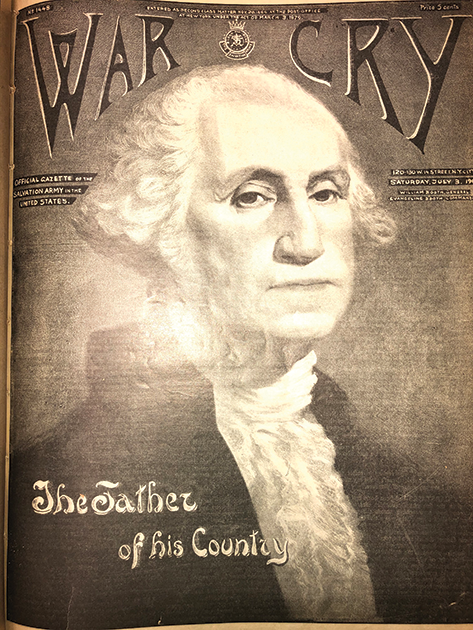
National Headquarters expanded its editorial department, which provided articles of national importance to the various versions of The War Cry and included more writers and designers. However, the department remained relatively small compared to other magazines. Even with this, the four U.S. territories had sections in each issue devoted to news of the territories. The year 1980 brought another significant change to The War Cry. National Headquarters took over the complete design and production of the national magazine, which freed up the four U.S. territories to develop a territory newsletter or regionally focused outlet.
The national War Cry would focus on evangelism, lifestyle and significant Salvation Army and national events and people.
From its beginnings, The War Cry was a weekly newspaper. As the magazine developed more of a national focus and territorial publications handled content specific to each region, the decision was made to switch to a bi-monthly, full color format and advance the threefold objective of providing inspiration, information about The Salvation Army and evangelism. Filled with helpful articles, the gospel message and news from around the Army world, the time came to upgrade the content and design according to contemporary standards. Cost savings realized by moving from a weekly to biweekly publishing schedule allowed for use of full color throughout the magazine, as well as upgrades in design, paper and focus. This emphasis on excellence and keeping pace with prevailing communications and publishing norms and procedures became a standard for The War Cry and its affiliated publications and projects.
Beginning in 2012, The War Cry switched from a bi-monthly to a monthly magazine. The cost savings realized by this change helped offset rising production costs and allowed for an increase in page count and depth of content and coverage, with some resources allocated to the development of online and social media content. At the same time, the special Christmas and Easter editions, both of which are distributed widely as a ministry tool, were merged with the December and March/April issues, respectively.
The War Cry made its debut online in 1995. These were early days, and by 2004, a new online presence was launched. As the internet grew in popularity and complexity, National Publications continued to expand and discussed the possibilities of the digital age. By 2014, another version of The War Cry online was launched. While the webpage continues to grow and change, viewers can see up-to-date news, longer online articles and find out more information than possible in the print version.
Today The War Cry is active on social media channels including Facebook, Instagram and Twitter. The Fight for Good Podcast, launched in 2019, expands on stories and profiles carried in the magazine, as well as carrying special interviews and content.

The magazine has never missed a beat over its 140 years, and has carried forward the profound, God-honoring content that forms the Army’s remarkable literary ministry and legacy. Its many great writers, artists and editors, both from the Army ranks and freelancers and professionals too numerous to mention, have built on Railton’s pioneering vision and gifts. Included are luminaries such as Robert Thomson, William Burrows, Sally Chesham, Henry Gariepy [OF], as well as Salvation Army leaders from William Booth to the present.
The sheer number of pages of The War Cry printed and shared over its history is impressive for its magnitude. The impact made for the Kingdom of God and the salvation of the world is written on hearts moved and guided by its unflagging commitment to proclaiming the good news of God’s love and how The Salvation Army is a unique expression of it.
For the foreseeable future, The War Cry will continue producing quality stories and articles that help get the message of the Gospel to people everywhere. William Booth wrote in 1879, “Why a War Cry?” Because the war cry is victory! “Victory over sin, victory over poverty, victory over despair.” And so, it remains today. Onward!
On to the conflict, soldiers, for the right,
Arm you with the Spirit’s sword
And march to fight;
Truth be your watchword,
Sound the ringing cry:
Victory, victory, victory!
Ever is the war cry,
Victory, victory!
Ever is the war cry,
Victory!
Write it on your banners,
Get it on your knees,
Victory, victory, victory!
-William Howard Doane, #970, Song Book of The Salvation Army
VIEW MORE WAR CRY COVERS:
This article was originally titled “Sound the Ringing Cry“ in the January 2021 issue of The War Cry.







